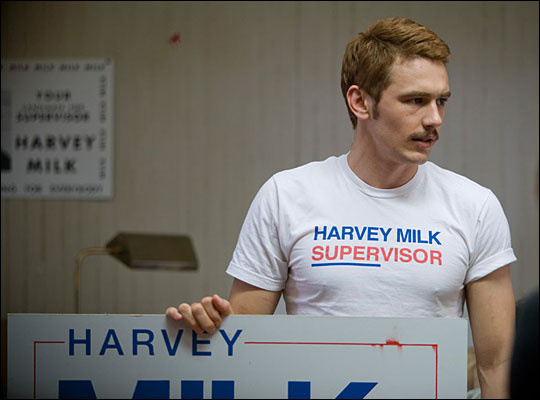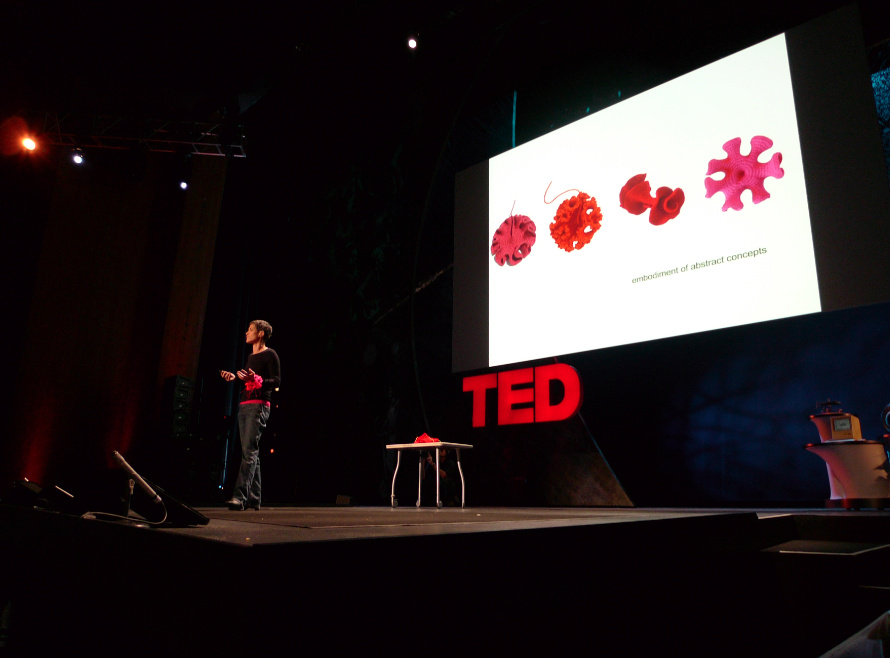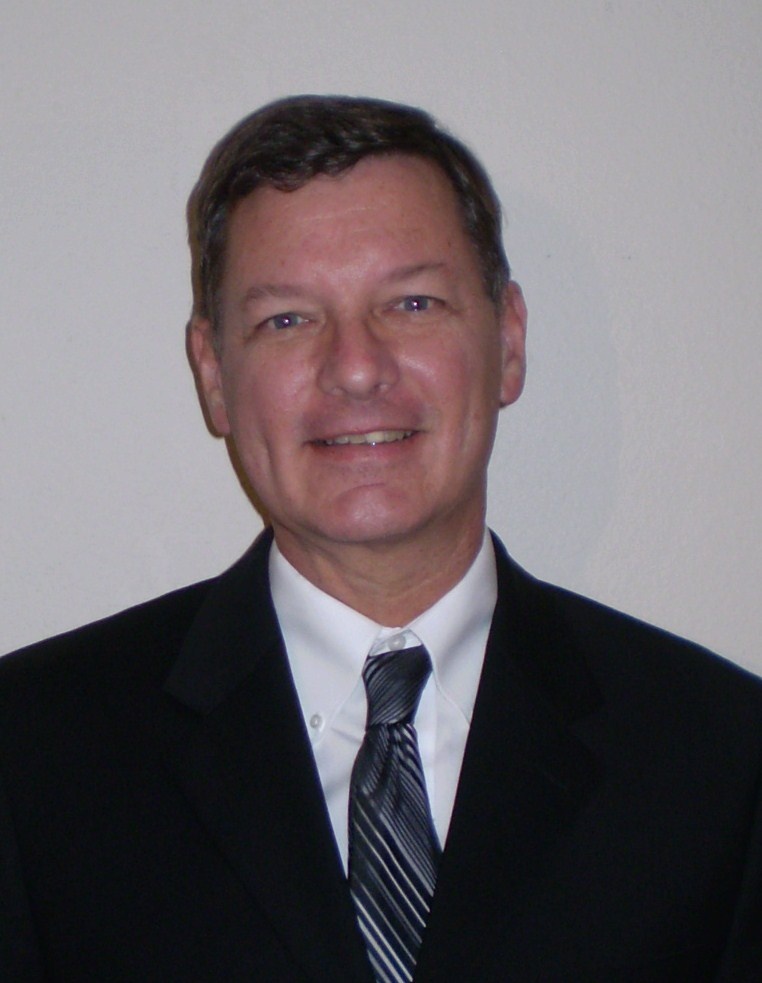![]()
Image from Gus Van Sant's Milk
Gus Van Sant’s first film to be released in theaters was Mala Noche (1985), based on the memoir of the same title by Portland poet Walt Curtis. It depicts Walt as a gay convenience-store employee attracted to a Mexican migrant worker. His most recent film, Milk (2008), portrays the life of gay activist,politician,and martyr Harvey Milk. (I played Harvey’s partner, Scott Smith.) Van Sant has made 11 feature films and a dozen shorts and music videos between these two movies, but only one other feature and one short—My Own Private Idaho (1991) and his segment from Paris, Je T’Aime,“Le Marais,” (2006)—center on gay characters and themes. Despite this lack of explicitly gay-themed films, Van Sant is hailed as one of the foremost gay directors working today. Part of this reputation undoubtedly derives from a desire to claim his high quality and original films for the gay community simply because he is a gay filmmaker. But there is another side to Van Sant’s oeuvre that is neither gay nor straight but subversively queer in its ambiguity. Van Sant inserts this queer sensibility in both gay and straight narratives that then de-centers any clear kind of sexual identity for his work as a whole.
Van Sant’s films embrace both classic Hollywood archetypes and queer cinema styles,usually set in his hometown of Portland, to create a unique amalgamation of trashy-chic timelessness. His characters and themes undermine the notion of fixed identities, experiences, and themes. At his queer best, Van Sant usually is dealing with young people, and seems primarily interested in the young white male: his sexual desires, his talents, but primarily the social pressures upon him. Often his characters are freighted with heavy emotional, economic, or addiction burdens—but they hardly ever struggle with identity. The characters are relaxed about who they are because they are almost invariably cool. Van Sant’s aesthetic is confidently queer in its refusal to categorize, in its overarching hipness of look and subject matter that is both in your face and elusive.
The exceptions among Van Sant’s characters are found in his first two films, Mala Noche and My Own Private Idaho, and Milk. These films are centered on gay identity and the struggles that come with that identity. Milk follows Harvey Milk’s political career in San Francisco in the 70s, and Van Sant presents identity politics as they were at the time. One of Harvey Milk’s strategies was to have people in the community come out in order to raise awareness and sympathy for gay causes. There is even a scene where one of Milk’s young cabinet members is pressured at a meeting to come out to his parents. This kind of explicit identification, anomalous to Van Sant’s greater body of work, is due to a loyal representation of the historical tactics of Harvey Milk. In Mala Noche, the gay protagonist, Walt, is irrepressibly in pursuit of a younger Mexican man, Johnny, but there is hardly any friction in the film over Walt’s sexual identity. Johnny rejects Walt because he “doesn’t sleep with queers,” but this hardly seems like the issue. After Johnny rejects him, Walt ends up sleeping with Johnny’s roommate, Roberto,who violently sodomizes him. This is the titular “bad night.” But the next day Walt is all smiles as he walks down the street, declaring in his voiceover:
“Though I was upset that I had been fucked,violated,and lost the money too,for a few moments thinking about it in the morning of the Mexicans gloating over having fucked the gringo puto and got his money too, talking about it and laughing, my ass sore. And the more I think about it the more I know I asked for a reckless evening.”
He may be disappointed in love,but it has nothing to do with identity insecurities. Even Johnny’s professed hatred of “faggots” is undermined by the suggestion that he is gay himself:
“He lives with nine or ten brothers. Maybe when they’re making love they can think about Roberto having fucked me. Roberto’s cock fucks Johnny fucked me, that’s about as close to Johnny I’ll ever get, unless I had the money, poor boys never win.”
Walt is completely confident in his sexuality as he calmly comments on Johnny and Roberto.None of Johnny’s lashes against homosexuality even carry any power because Johnny is the original prototype of Van Sant’s androgynous young man.
Following Mala Noche there are hardly any mature gay characters that pine after the ubiquitous young androgynous men, but the films themselves capture these young males in such a way that the adoration is still felt. The exception to this might be Milk,in which Harvey Milk carries out two relationships with younger men, but in these cases there are absolutely no issues regarding the sexuality of the partners. The relationships are presented like any straight relationship might be captured in a mainstream Hollywood film. The other factor that stands out about these two relationships compared with those in Van Sant’s other work is the attention paid to physical interaction. Granted, the sexual content in Milk is tame next to most films, but Van Sant’s sex scenes,same-sex or otherwise,are usually highly stylized and obscured. In Milk Van Sant lingers on the kissing, which is portrayed as sweet and romantic, rather than passionate. This portrayal of gay romance is akin to representations of gay lifestyles of the time as seen in Rob Epstein’s documentary from the 80s, The Times of Harvey Milk, and his earlier project, The Word Is Out, where the sex is either elided or presented as close to heterosexual depictions as possible.
The stylized sex scenes begin with Mala Noche and continue through Milk, although they find their most frank expression in the latter. The eponymous scene of Mala Noche is shot in quick cuts and very dark lighting full of shadows that obscure most of the action. One of the actors was only willing to do the sex scene if his naked body didn’t touch another man’s naked body,which must have contributed to the parameters for shooting the scene. The result is a highly fractured and impressionistic scene that hardly celebrates same gender sex. Van Sant’s subsequent outing, Drugstore Cowboy (1989), has no sexual content as it is replaced by the sensuality of narcotic injections. His next film, My Own Private Idaho introduces the first highly stylized sex scenes in Van Sant’s oeuvre suggesting that the stylization is in fact deliberate and not necessarily due to the performance restrictions imposed by the actors. In all of the sex scenes the fairly naturalistic style of the movie is interrupted by montages. It suggests a frozen moment with life underneath. There is beauty without any of the squeamishness of explicitly depicted sex, almost like a painting or sculpture that points to an ideal without the messiness of the carnal. This was a deliberate choice by Van Sant but it is curious that in the one sex scene with River Phoenix, he is not nude like the other actors but wears a pair of bright pink shorts. This is because Phoenix, 20 years old at the time, had promised his mother that he wouldn’t get nude for the role. Regardless, Phoenix’s pink shorts are incredibly conspicuous and point to another possible factor for how Van Sant’s stylizes his sex scenes: the actors are too young to engage in them.
In To Die For (1995), Elephant (2003), and Paranoid Park (2007) sex scenes are suggested but the actors are again too young to act them out explicitly, and the scenes are thus forced into an elliptical framing. To Die For features another older/younger sexual interaction,and although it is a heterosexual coupling between characters played by Joaquin Phoenix and Nicole Kidman,it also shows sex as a manipulative gesture from Kidman’s character, completely devoid of emotion. To convince the younger man to murder her husband, Kidman’s character gives Phoenix’s character a blowjob, performed offscreen. In Elephant, Van Sant makes the interesting choice to make the killers lovers. Immediately before we see the two teenage boys massacre their fellow high school students,they shower together, and it is suggested that they kiss. The shot is wide and the boys are only seen chest up through the frosted shower door. Their heads align and move as if they were kissing. (The actors actually never kissed; they just moved their heads in such a way to suggest they were kissing.) The same situation is true for the sex scene in Paranoid Park where the young man and young woman both lose their virginities. Van San shoots them in extreme close-up,because they were too young to be filmed with their clothes off. Thus, the scenes all feel austere and distant. The sex between young characters is either idealized as in My Own Private Idaho, or it is distant and cold as it is in Paranoid Park, or it is a strange combination of the two as in Elephant, where the boys are allegedly allowed to engage in desires that were formerly repressed, presumably a liberating sensation, although the affection is muted by the shot composition.
Because the sex scenes are always so cold or obscured,they strip the sexual interactions of their sexual charges creating a queer kind of ambiguity. Van Sant has stated that he intended Elephant to be a compilation of all possible factors that contributed to the Columbine massacre including video games, bullying, and neglectful parenting. All these things were written about Eric Harris and Dylan Klebold after the Columbine massacre, but the killers’ being gay was never mentioned, let alone cited as a motivation for the killing. Van Sant claims that he included a kissing scene in the shower because the characters suddenly felt uninhibited because they knew they were going to die. Thus these otherwise “straight”-seeming boys were not only picked on for being uncool,but were sexually isolated as well. Here, because Van Sant has included this unusual and distinct moment, the killing is no longer just a recreation of the Columbine killing; it is also a violent expression of the sexually repressed queer striking back. Similar to the violent expression of the protagonist in Monster, these killings aren’t just journalistic recreations of actual events; they are extreme expressions of repression fighting back. But the kissing scene in the shower is so brief and difficult to engage with it can’t be cited as the main motivation for the killing, it is just one of many possible motivations. Thus, the repression and pressure on these boys that is revealed in this moment is tied to other queer pressures in other films.
Paranoid Park continues this line of ambiguous queerness filtered through an ostensibly heterosexual suburban boy’s experience. To achieve the same kind of repressive pressure that weighs on all his young protagonists, this boy Alex (played by Gabe Nevins) is accidentally involved in the death of a man. The secret of his involvement stands in for other secrets. The movie is couched in a narration that is ostensibly Alex’s journal writings,which are all about the murder, and the audience is privy to his secret life and thoughts through this device,and the overarching tension of the film rides on his potential “coming out”— where he is either caught or admits his crime. This tension then infuses the rest of Alex’s activities with great pressure. The film is hardly concerned with the crime as much as it is with Alex’s reaction to the crime and the resulting emotions, which are felicitously close to those that any young queer person might feel in a heteronormative high school where every guy is supposed to want to have sex with the cheerleaders.
The androgynous young male is a motif that runs through all the films and allows Van Sant to deal with queer themes in what are often seemingly heteronormative narratives.These androgynous young characters become more prominent and more significant post-Good Will Hunting.After the huge critical and financial success of that film, released in 1997, Van Sant redid Hitchcock’s Psycho (1998) and then made Finding Forrester (2000). Forrester was a decidedly nonsexual take on the older male/younger male mentor relationship found between Scott, the Hal character and Bob, the Falstaff character in My Own Private Idaho and the therapist/patient relationship between Robin Williams character and Matt Damon’s character in Good Will Hunting. The original Psycho provided the prototype for all queer serial killers of the past fifty years, and Van Sant’s Norman Bates is certainly queer, but not the ambiguous androgynous young queers that he does to perfection.
Van Sant is characterized as a gay filmmaker because he is an out filmmaker,but his films are anything but gay films.Van Sant is less interested in the sexual identity of his characters than he is in a more universal queering of his characters.His young androgynous men cross all borders of sexual identification: they identify as straight and gay,but underneath the surface they also cross borders of sexual signification. There is no way to pin them down and thus they are queer and subversive,rather than gay and categorized. But more than that they are inevitably fashionable and hip. These characters are undeniably attractive so that their queerness is even more disarming. They have the aesthetic of the streets and of the downtrodden and of the young. They are the vessels of Van Sant’s ambiguity.
More James Franco on VICE:
Universalizing Art: 'The Disaster Artist' and 'The Room'









































